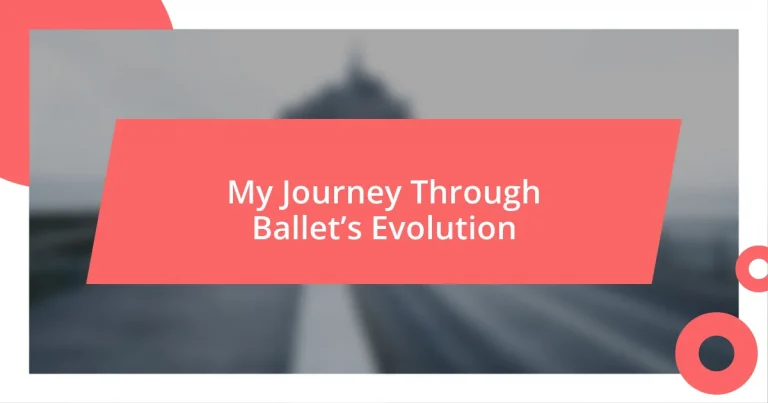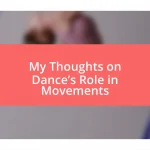Key takeaways:
- Ballet originated in the Renaissance period, evolving from royal court festivities to a narrative art form enriched by cultural influences, notably during Louis XIV’s reign.
- Key figures like Louis XIV, Marius Petipa, and Misty Copeland have profoundly shaped ballet’s development, introducing techniques and diverse narratives that continue to inspire today.
- Contemporary ballet trends emphasize inclusivity, emotional expression, and technological integration, illustrating the art form’s adaptability and connection with audiences.
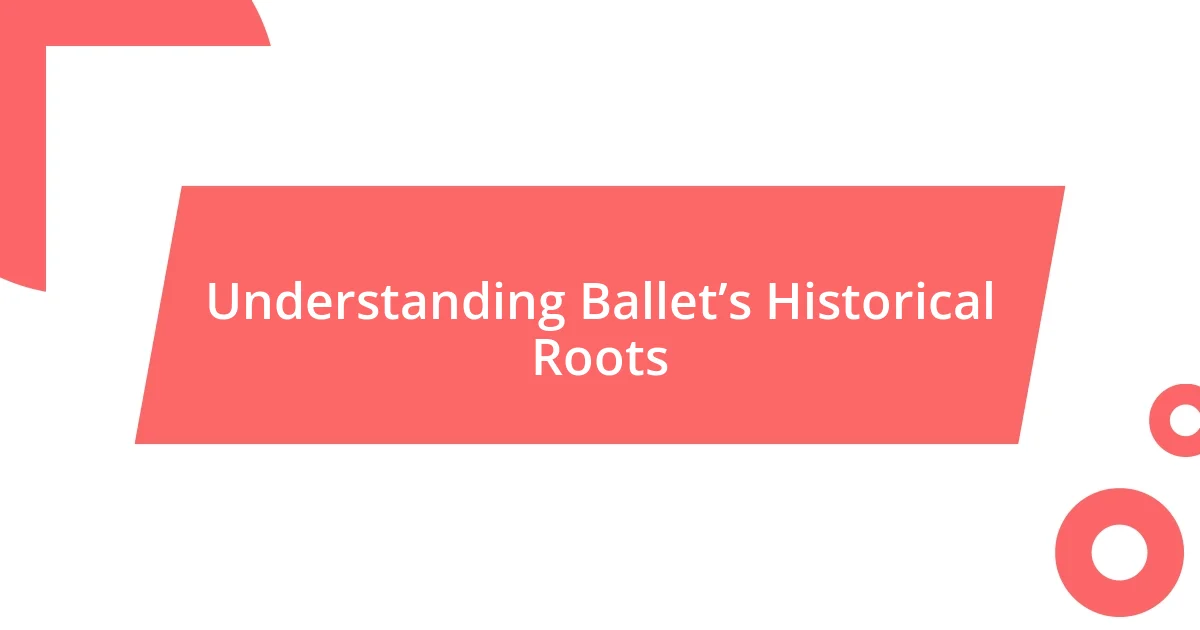
Understanding Ballet’s Historical Roots
Ballet’s roots trace back to the Renaissance period in Italy, where it blossomed in royal courts as a form of social dance. Can you imagine the elegant gatherings, where nobility would glide across the floor, choreographed to exquisite music? I often find myself moved by the beauty of this transformation – from courtly entertainment to a celebrated art form.
As I learned more about ballet’s evolution, I was surprised to discover how it was influenced by the cultural tides of each era, especially during the French reign of Louis XIV. His passion for dance not only elevated the art form but also established the first ballet school. What a powerful statement about how one individual’s love can shape the future, right? Reflecting on this, I feel a deep connection to the way passion fuels creativity.
The shift began when ballet started to embrace storytelling through movement, eventually leading to the narrative-driven performances we cherish today. This evolution resonates with me personally; every time I watch a ballet, I think about the rich history behind each step and how those early dancers expressed their emotions. Isn’t it fascinating to recognize that every pirouette and plié carries the weight of centuries of tradition?

Key Figures in Ballet Evolution
Within the world of ballet, certain figures stand out for their profound impact on its evolution. They’ve shaped the direction of the dance form and have left legacies that still echo today. For instance, Jean-Georges Noverre is often credited with pioneering ballet d’action, an approach that aimed to focus on expressive movement and storytelling. I still remember feeling a rush of excitement the first time I encountered his work—it was like stepping into a world where every movement told a story, drawing me into the emotions of the characters and their journeys.
Key figures who contributed significantly to ballet’s evolution include:
- Louis XIV: The Sun King, who established the Académie Royale de Danse, setting the foundation for ballet training.
- Marius Petipa: A choreographer whose compositions like “Swan Lake” and “The Nutcracker” have become staples in the ballet canon.
- George Balanchine: A revolutionary choreographer known for his role in shaping American ballet and introducing neoclassical ballet.
- Vaganova: Developed the Russian ballet method which emphasizes strength and expressiveness through meticulous technique.
- Misty Copeland: A trailblazer in the modern ballet scene, she broke barriers as the first African American principal dancer at American Ballet Theatre, inspiring many with her journey.
Reflecting on these figures really helps me appreciate the layers of history behind the art. Their stories lend a richness to the performances I watch and remind me how dance can evolve while remaining deeply rooted in tradition. Dancing feels even more powerful knowing the trailblazers who came before, each contributing their unique flair to the ballet tapestry. It makes every performance a tribute to their legacy.
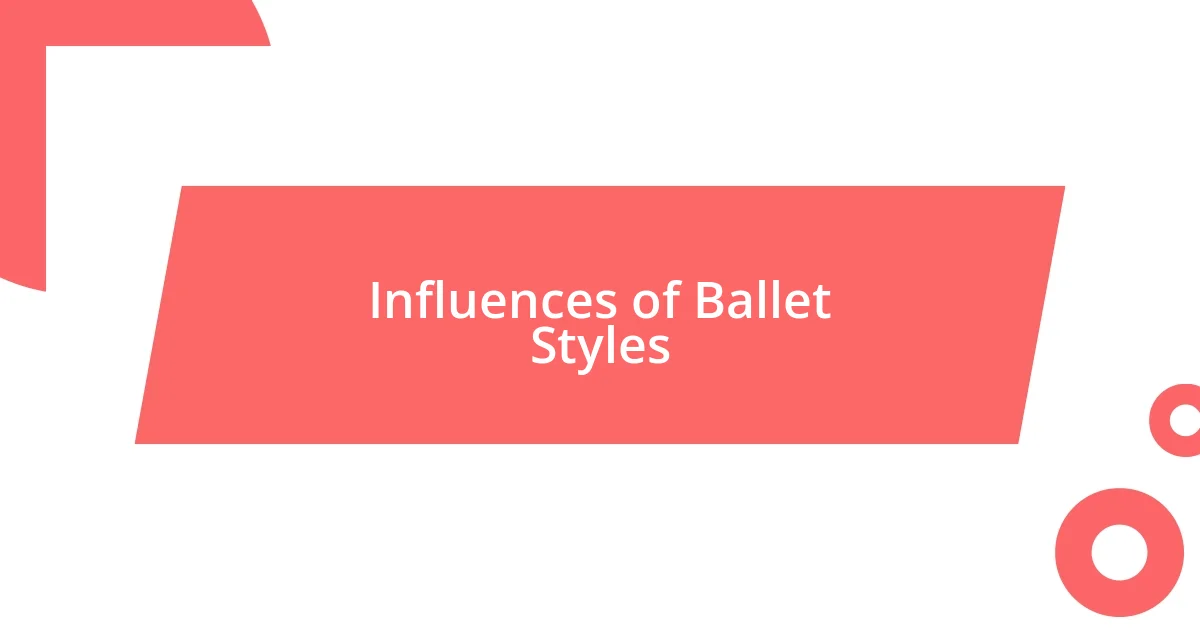
Influences of Ballet Styles
The evolution of ballet styles has been dramatically shaped by geographical and cultural influences. For instance, classical ballet, with its origins in the French courts, emphasizes strict technique and formalized movements. I vividly remember attending a performance where the precision of the dancers left me in awe; their movements felt both mathematical and magical, a beautiful testament to the rigor of tradition. In contrast, contemporary ballet embraces a more liberal approach, often integrating elements from modern dance, which allows for greater expression and creativity. I felt a sense of liberation when I saw a contemporary piece that broke free from classical conventions, revealing how ballet can adapt and grow while still honoring its roots.
Ballet has continually drawn inspiration from other dance forms, reflecting the cultures they emerge from. For example, the Russian style, with its dramatic flair and emotional intensity, deeply moved me during a visit to the ballet. The passionate expressions of the dancers conveyed a sense of storytelling that resonated with my own experiences. Similarly, the influence of folk dances in ballet creates a dynamic cross-pollination of styles, inviting dancers to explore a variety of movements and narratives. This adaptability is thrilling; it allows ballet to remain relevant in an ever-changing artistic landscape.
The blend of classical and contemporary styles creates a rich tapestry that showcases ballet’s versatility. I love how each performance can evoke different emotions, depending on the style presented. I recall a duet that beautifully merged classical elements with modern gestures, striking a balance that was both nostalgic and refreshing. This interplay between styles illustrates the ongoing dialogue within ballet, reminding us that it is as much a living art form as it is a historical one.
| Ballet Style | Influences |
|---|---|
| Classical Ballet | French court tradition, emphasizing technique and formality |
| Contemporary Ballet | Integration of modern dance, allowing for more expressive and creative movement |
| Russian Ballet | Emotional intensity and dramatic storytelling |
| Folk Dance Influences | Dynamic blend of cultural movements added to ballet’s evolution |

Major Ballet Techniques Explained
Ballet techniques vary widely, each with its own nuances and characteristics. One of the most fundamental techniques is the French style, which prioritizes a precise foundation. I recall the sense of discipline I felt while training in this technique; every plié and relevé was not just a movement but a step towards mastering control and elegance. The keen emphasis on body alignment and turnout made each practice feel like sculpting my body into a work of art.
Then there’s the Russian method, celebrated for its dramatic expressiveness. I remember watching a performance that exemplified this style, where the dancers poured their hearts into each leap and turn. The intensity was palpable—it felt like they were telling a story that resonated with my own emotions. This technique blends strength with artistry, allowing performers to channel deep sentiments into their movements. It’s fascinating how such techniques can evoke profound feelings in both dancers and audiences; have you ever felt a connection so strong that it made your heart race?
On the flip side, the Balanchine technique fosters a sense of fluidity and musicality, unlike anything else I’ve experienced. Attending a class focused on his style opened my eyes to how movement can intersect with music to create something extraordinary. The way dancers seem to dance in sync with the rhythm rather than just follow it felt like magic. This technique encourages rapid transitions and a sense of lightness, often leaving me breathless and hungry for more. Isn’t it incredible how diverse these techniques are, yet they’re all bound by a shared love for dance?
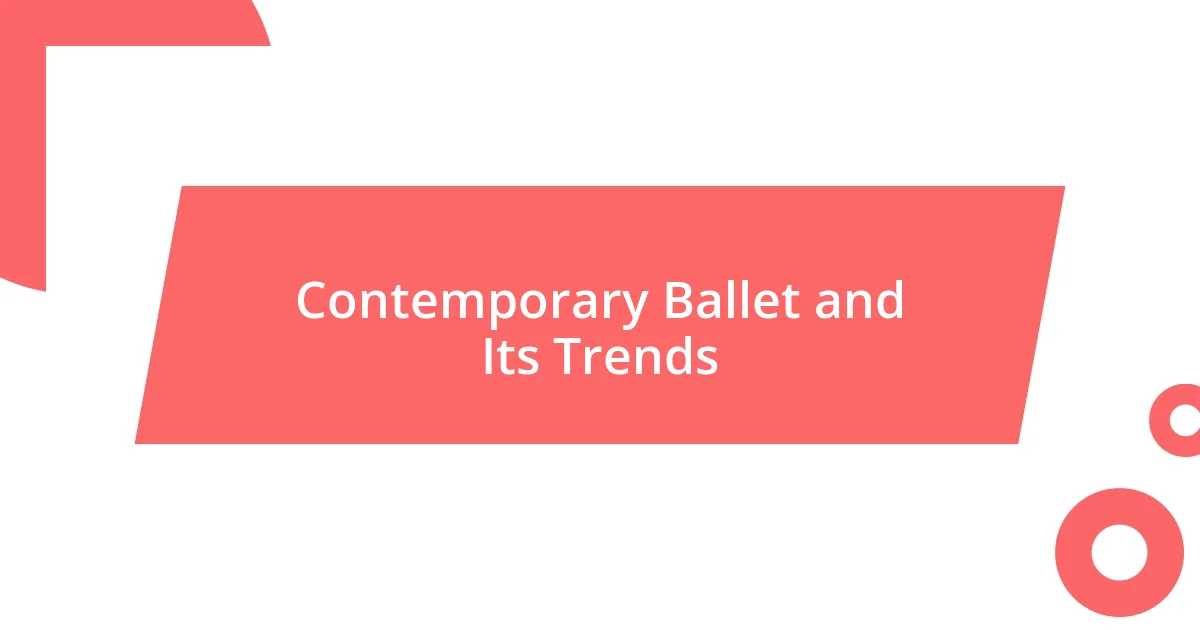
Contemporary Ballet and Its Trends
Contemporary ballet stands out by merging classical training with innovative ideas. I remember attending a contemporary ballet workshop where the instructors encouraged us to explore our individual movements beyond structured steps. This experience truly opened my eyes to the idea that dance can be an emotional outlet, rather than just showcasing technique. I often find myself wondering how ballet can evoke such a range of feelings—how does movement transform into expression?
Currently, one of the exciting trends is the focus on inclusivity and diverse narratives within contemporary ballet. I was particularly moved by a performance that celebrated various cultural backgrounds, allowing dancers to share their stories through movement. It’s remarkable to see how this evolution promotes a deeper connection with audiences, making ballet more relatable than ever. Have you ever felt that connection during a performance that resonates with your personal journey?
Another fascinating trend is the incorporation of technology, such as video projections and digital effects, to enhance the storytelling aspect of contemporary ballet. I recall a mesmerizing show where dancers interacted with projected visuals, creating a captivating fusion of movement and imagery. This innovative approach prompts me to think about the future of ballet; how will it continue to evolve with advancements in technology? The potential feels limitless, and it makes me excited for what’s to come in this beautiful art form.
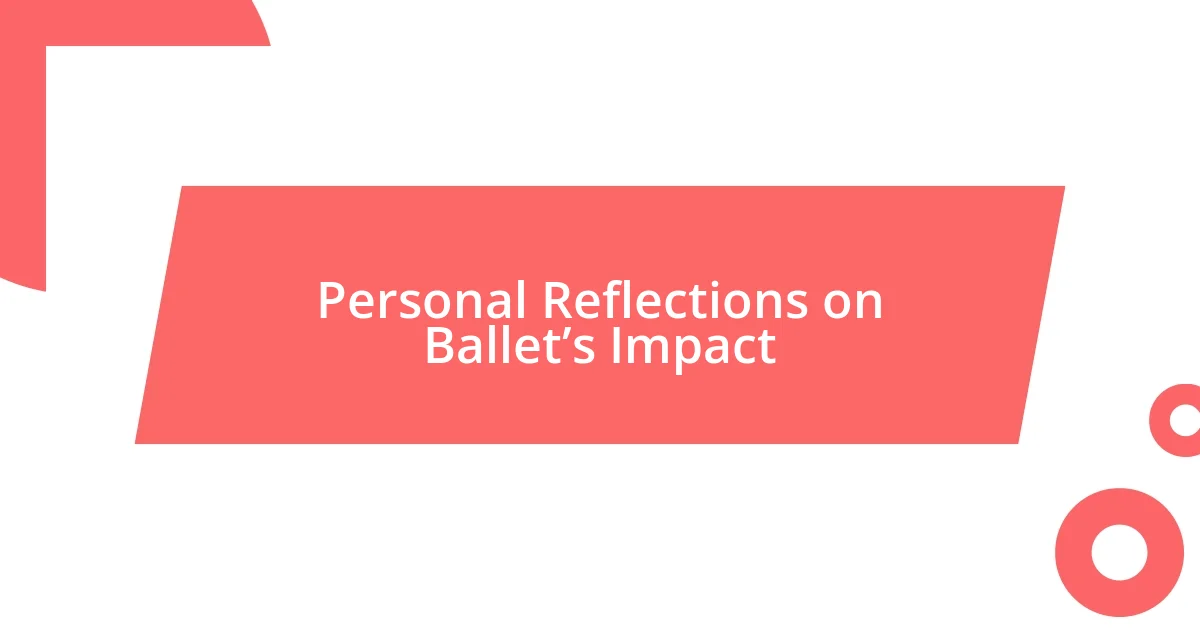
Personal Reflections on Ballet’s Impact
Reflecting on ballet’s impact, I can’t help but appreciate how it shaped not only my physical abilities but also my emotional resilience. I recall a time when I faced a challenging piece that seemed beyond my reach. While practicing relentlessly, I experienced transformation—progressing from frustration to triumph taught me the value of perseverance, a lesson that has been invaluable beyond the studio. Have you ever found yourself pushed to your limits, only to discover strength you didn’t know you possessed?
Ballet has also profoundly influenced my understanding of artistry and expression. Once, during a performance, I became so engrossed in the story we were conveying that the world around me faded away, leaving just the music and movement. The emotions that flowed through me during those moments were indescribable—it was as if I was translating my soul into dance. It’s intriguing to think about how this form of expression allows us to communicate feelings that words often fail to capture, isn’t it?
Moreover, ballet has introduced me to an incredible community where shared passion fosters friendships and support. After a particularly intense rehearsal, my peers and I gathered for a casual chat about our experiences and aspirations. That feeling of camaraderie—of understanding each other’s struggles and celebrating our joys—reminds me why I cherish this art form so deeply. Isn’t it beautiful how art can unite people, creating bonds that extend far beyond the dance floor?












